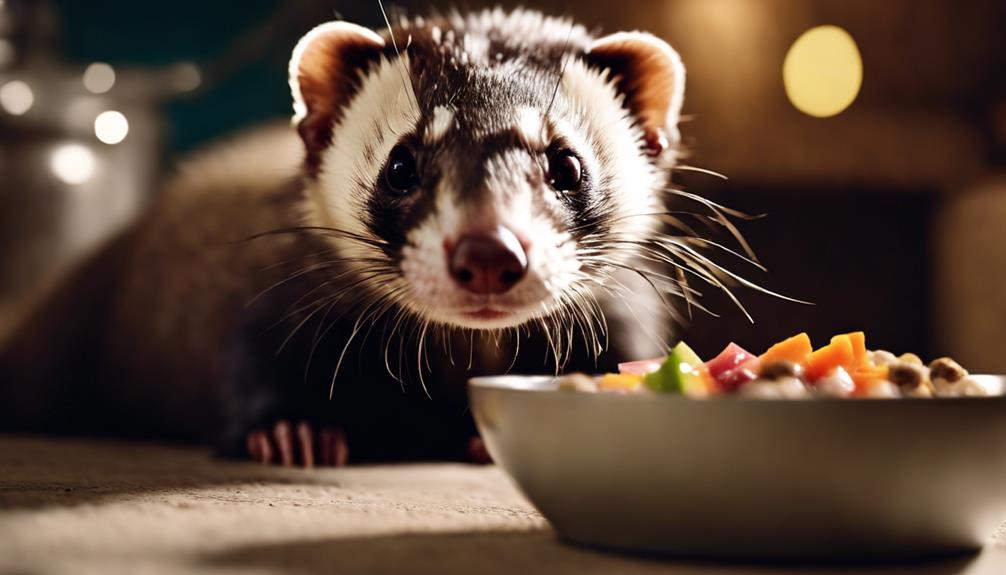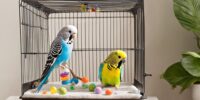How to Transition Your Ferret to a New Food

Tips for Transitioning Your Ferret to a New Food:
Start by mixing small amounts of the new food with their current diet, gradually increasing the proportion over 7-10 days.
Monitor your ferret for any signs of digestive upset during the transition period.
Ensure the new food meets their nutritional needs to keep them healthy and happy.
Assess Current Diet
When evaluating your ferret's current diet, consider both the nutritional content and the quality of the ingredients they're consuming. It's essential to assess the ingredients listed on your ferret's food packaging to ensure they're receiving a well-balanced diet. Look for high-quality proteins like meat, as ferrets are obligate carnivores and require a diet rich in animal-based proteins. Additionally, check for the presence of essential nutrients such as taurine, which is crucial for your ferret's overall health.
Monitoring your ferret's weight is another crucial aspect of assessing their current diet. Sudden weight loss or gain can be indicators of an improper diet or underlying health issues. Regularly weigh your ferret and consult with a veterinarian if you notice any significant changes in their weight. By evaluating both the ingredients in their food and their weight, you can gain a better understanding of your ferret's dietary needs and make informed decisions about transitioning to a new food.
Choose New Food

When selecting a new food for your ferret, it's crucial to conduct a thorough nutritional needs analysis to ensure all dietary requirements are met.
This process should be approached with care and patience, gradually transitioning your ferret to the new food to prevent any digestive upsets.
Nutritional Needs Analysis
To ensure your ferret receives the appropriate nutrition during the transition process, carefully select a new food that meets their specific dietary requirements. Ferret health and dietary requirements should be the primary focus when choosing the right food.
Look for options with high nutritional value and top-quality ingredients. Ferrets are obligate carnivores, meaning their diet should consist mainly of meat-based proteins. When evaluating potential foods, check for ingredients like chicken, turkey, or beef as primary sources of protein.
Avoid foods with excessive carbohydrates and fillers, as these can lead to health issues in ferrets. Prioritizing the nutritional needs of your ferret will lay a solid foundation for a successful transition to a new food that supports their overall well-being.
Slow Transition Process
Begin the transition process for your ferret's new food by selecting a high-quality option that aligns with their specific dietary needs and preferences. To help you make an informed decision, here are some quick tips to guide you through the selection process:
| Quick Tips for Choosing New Food | Description |
|---|---|
| 1. Check ingredient list | Ensure it meets your ferret's needs |
| 2. Consider protein content | Ferrets need high protein diets |
| 3. Avoid sugary treats | Stick to nutritionally dense options |
| 4. Opt for grain-free options | Mimics a more natural diet for ferrets |
| 5. Look for essential nutrients | Ensure the food is balanced |
To prevent transition mistakes, gradually introduce the new food over 7-10 days by mixing small amounts with the old food, increasing the new food portion daily.
Gradual Mixing Method

When transitioning a ferret to a new food using the Gradual Mixing Method, it's essential to start with small portions of the new food mixed in with their current diet. Slowly increase the amount of the new food over several days to allow your ferret's digestive system to adjust.
Monitor your ferret closely during this process to ensure they're responding well to the new diet.
Small Food Portions
Gradually introduce the new food by starting with small portions mixed in with their current food to help your ferret adjust to the transition smoothly. This method ensures proper portion control and takes into account your ferret's dietary preferences. Below is a table that exemplifies how to incorporate small food portions into your ferret's diet during the transition period:
| Day | Current Food (%) | New Food (%) |
|---|---|---|
| 1 | 90 | 10 |
| 2 | 80 | 20 |
| 3 | 70 | 30 |
| 4 | 60 | 40 |
Increase New Food
To smoothly incorporate more of the new food into your ferret's diet, continue adjusting the portions gradually as outlined in the table, ensuring a balanced transition. Remember, a slow introduction to the new food is key to prevent digestive upsets and refusal to eat. Patience and consistency are vital during this process to help your ferret adapt at their own pace.
Here are three essential tips to help you increase the new food effectively:
- Mix a slightly higher proportion of the new food with the old food every few days.
- Observe your ferret's reaction to the new food and adjust the ratio accordingly.
- Provide plenty of fresh water and monitor your ferret's hydration levels during the transition.
Monitor Ferret's Response
Observing your ferret's response to the new food through the gradual mixing method is crucial for gauging their acceptance and adjusting the transition accordingly. Keep an eye out for any behavioral changes such as increased or decreased interest in food, changes in activity levels, or alterations in litter box habits.
Additionally, weight monitoring is essential to ensure your ferret is maintaining a healthy body condition throughout the transition process. Watch for any signs of digestive issues like diarrhea, vomiting, or constipation, as these could indicate that the new food isn't agreeing with your ferret.
Monitoring for allergies is also important; look for symptoms like itching, redness, or gastrointestinal upset. By staying vigilant and responsive to your ferret's reactions, you can successfully transition them to a new food with minimal stress and potential health issues.
Monitor Ferret's Reaction

Keeping a close eye on your ferret's response to the new food is crucial during the transition process. Observing behavior and tracking progress can help you ensure a smooth changeover. Here are some essential points to consider:
- Behavior Changes: Watch for any changes in your ferret's behavior after introducing the new food. Signs of excitement, hesitation, or rejection can give you valuable insights into how your ferret is adjusting.
- Physical Health: Monitor your ferret's physical health during the transition period. Look out for any digestive issues, skin reactions, or changes in coat quality that could indicate a negative reaction to the new food.
- Eating Habits: Keep an eye on your ferret's eating habits. Note if they're consuming the new food eagerly, picking at it, or avoiding it altogether. Understanding their eating patterns can help you tailor the transition process to suit their preferences.
Adjust Transition Pace

When transitioning your ferret to a new food, it's crucial to adjust the pace of the changeover to suit your pet's individual needs and comfort level. To do this effectively, monitor progress closely and be prepared to adjust the pace accordingly.
Start by introducing small amounts of the new food mixed with the old one, gradually increasing the proportion of the new food over time. This slow transition helps prevent digestive upsets and allows your ferret to acclimate to the new taste and texture.
Observe your ferret's behavior throughout the transition period. Look for signs of reluctance, such as refusing to eat or changes in litter box habits. If you notice any negative reactions, consider slowing down the transition process or reverting to the previous food for a while before trying again.
Tweak the transition based on your observations to ensure a smooth changeover for your furry friend. Remember, every ferret is unique, so be patient and flexible in adjusting the pace to suit their individual preferences and needs.
Seek Veterinary Guidance

To ensure the well-being of your ferret during dietary changes, consulting with a veterinarian is essential for expert guidance tailored to your pet's specific health needs. When seeking veterinary guidance, consider the following:
- Professional Recommendations: A vet can provide insights into the best food options for your ferret based on their age, health status, and any specific dietary requirements they may have.
- Health Monitoring: Consulting a professional allows for proper monitoring of your ferret's health during the food transition, ensuring any adverse reactions or health issues are promptly addressed.
- Tailored Advice: Veterinarians can offer personalized advice on how to transition your ferret to a new food gradually, taking into account their individual preferences and dietary considerations.
Establish New Feeding Routine

Establishing a consistent feeding schedule is crucial for ensuring a smooth transition to a new food for your ferret. To begin, gradually adjust the feeding times to align with the new food routine. Ferrets thrive on routine, so maintaining regular feeding times helps them feel secure and aids in the transition process.
When establishing consistency, it's essential to monitor your ferret's appetite and behavior closely. Some ferrets may be hesitant to try new foods, so patience is key. Introduce the new food slowly, mixing it with the old food initially, and gradually increase the proportion of the new food over several days.
Feeding schedule adjustment should be done gradually over 7-10 days to allow your ferret's digestive system to adapt. Ensure that fresh water is always available, and monitor your ferret for any signs of digestive upset during the transition. By being attentive to your ferret's needs and making gradual changes, you can help them adjust comfortably to their new food.
Frequently Asked Questions
Can I Mix Dry and Wet Food When Transitioning My Ferret to a New Diet?
When transitioning a ferret to a new diet, mixing dry and wet food can be beneficial. Start with a higher ratio of the old food, gradually increasing the new food. Ferrets might have texture preferences, so observe and adjust accordingly.
How Often Should I Offer Treats During the Transition Process?
During the transition process, it's essential to offer treats sparingly to avoid upsetting your ferret's stomach. Treats can be given occasionally as rewards for positive behavior during training sessions. Playtime and enrichment activities are great for bonding and mental stimulation.
Are There Specific Ingredients I Should Avoid When Choosing a New Food for My Ferret?
When choosing a new food for a ferret, it's important to avoid ingredients that could trigger allergies. Ensuring nutritional balance is key. Some common allergens to watch out for include grains, dairy, and artificial additives.
Can I Mix in Supplements or Probiotics During the Transition Period?
During the transition period, mixing supplements or probiotics with the new food can benefit a ferret's health. This method helps ease the change and supports their digestion. Slowly incorporating these additives can aid in a smoother transition.
How Long Should I Wait Before Introducing a Different New Food if My Ferret Doesn't Seem to Be Adjusting Well to the Current One?
When a ferret struggles with adjusting to a new food, it's essential to be patient and observant. The transition timeline varies, but a general rule is to wait at least a week before introducing a different new food. Taste testing can help determine food preference.










